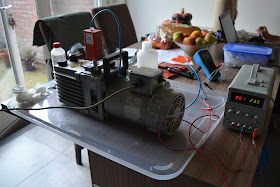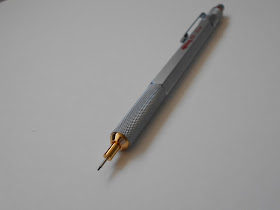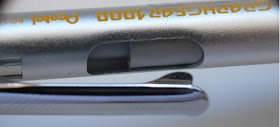High vacuum is one of those things that really suck.... Sorry, couldn'd help it.
Parts are expensive, finnicky and not always readily available to anyone.
I recently bought an Edwards E2M12 vacuum pump for a project of mine. When I got it, it came without any oil and without any idea of the state it was in. But for the money I paid, I couldn't just pass it.
So, I now have a vacuum pump... what now?
Well, to be able to make it suck in the proper way, I needed to give it an overhaul So first thing's first.. get an overhaul kit. How hard can it be?
Well, very hard, apparently, unless you're a company. Very limited opportunities for those of us not blessed with a VAT number.
Most of the suppliers out there, including Edwards themselves only sell to companies and the only source for the kit I found, charged a hell of a premium for it and asked a metric ton of money for shipping something that weighs in a couple of hundred grams.
As reference, here's a list of stores that have Edwards supplies and kits, together with my rants comments
- www.vacuumpumpsupply.com This is where I bought my kit from. A bit over-priced, but hey....at least they sold me one They do deal with individuals, not just companies, so that's perfect. However the shipping was very expensive even from the USA to Europe. Also, 0 points for customer support. I litterally tried calling them tens of times but nobody answered. Also all my emails sent to them requesting some info about the order went unanswered. But hey, they don't need to answer any phones or mails when they get a wad of money from their customers
- www.idealvac.com Yep, they also have kits and yes, they do do business with individuals, but they're even more expensive than the previous guys.And shitty shipping policy. If you're from the US, they're...ideal. If not, tough cookies then.
- https://shop.precisionplus.com European store from what I can figure. Pretty low prices, but they only deal with companies. Only found out after about a week of trying to get someone there to look into why my account was not active. Though if you can borrow a friend's VAT number, they have the lowest prices as far as I've seen.
- https://www.jrtech.fr/en/ A lot of supplies here. Regarding my kit, they only had it from some off-brand company. Not original from Edwards. Could be helpful in a pinch, though.
- http://www.mascom-bremen.de/html/de/content.html Also a lot of suck-related stuff, but... yes, you guessed it... companies only
- https://www.labunlimited.com/ Just thought I'd throw it in here, just in case. Never know who might find it useful

Was wondering what happened to all 4 of my mails and the 10+ phone calls or so. But the EM12 kit is finally here. Now what?
Well, easy if you know you way around one of these things. Not so much if you're a noob like me. So, we seek the help of the collective hive mind.
This helped me out a great deal. Nice write-up, and a lot of other useful links and info in the posts. Seeing how many models of these vacuum pump are out there, I thought I'd post my own adventure together with some helpful pics. Be sure to have a look through all the posts on the EEVBlog link before you start working on your pump.
First thing's first: flush out the pump. That is, drain whatever oil there is in the pump then fill it with some cleaning fluids. Paint thinner is recommended in the link above, but I couldn't find anything useful, so I used some denatured alcohol. It doesn't do a great deal to dissolve the oil but it does flush out any dirt and in my case, spider webs and is safe on the seals. Of course, the E2M12 is well made and no ball bearings inside to screw up with aggressive solvents. But I went the safer route.
Yep, guessed it... the blue stuff... denatured alcohol. Even after this step, there will still be oil left if you plan on tearing down both stages of the pump So have a lot of rags on hand or have a big sheet of plastic on your work table / space. I had a big plastic tupperware lid on the table, so it'd catch any oil spills.
Next step would be to get some service manuals for the pump. You can also find those in the previous link. As a side note, the M2, M5, M8 and M12 are functionally the same.
If you plan on taking this thing apart, make things easy. Separate the motor from the pump first. This will make everything much easier when handling. Start with the two red plastic parts either side of the pump.
On mine, the coupling to the motor has two keys on either end of it and two grub screws (#1 and #2 in the pic below) Undo both of these and then the four Allen bolts holding the motor to the pump's frame.
Then you can just pull the motor away from the pump. 2 people are ideal for this task, but being the proud engineer that I am, and also being alone in the house, I did it by myself.
My pump didn't come with a plate underneath. If yours has this, also undo the bolts holding the motor to it.
Putting aside the motor and focusing on the pump itself, undo the four allen bolts holding the pump cover....after you've drained everything from the pump, that is.
You can use a plastic or wood shim to pry the two halves apart.
Now that you're in like Flynn, how about you take off that thin steel plate held with those two allen screws.
And, while you're at it, undo the other two and the small aluminiun block holding that copper pipe (gas ballast tube) in place. Slide the cast rear cover plate down about 1 or 2 cm and slowly but firmly pull on the pipe. It comes out easily, just be sure not to bend it too much.
Once the plate is off, you have access to one of the pump's stages.
If you want to go ahead and take out the vanes, a word of caution. They're made out of some kind of phenolic resin so do not grab then in any way. Handle them like you would one of your french girlfriends.
I, on the other hand, took a dental pick and pried them out by hooking onto the spring inbetween the vanes. Another way to do it is also mentioned in that link from EEVBlog... take out the screws holding the pump stage (LV stator) to the rest of the body and slide it out a bit. 1 cm should do it, then push it back in. This should expose the vanes just enough so you can get them out.
Sources mention there is also a bolt in the middle of the now exposed shaft. Mine didn't have something like that. Seems they modified the design through the years.
So all I had to do to get to the next stage was to only undo the allen bolts of the LV stator. The alignment to the main body is ensured by two precision ground pins. Easy, right?
Well, it depends. This is the actual tricky part of the whole thing. The mating surfaces of the two parts are machined and can actually stick together.
There's two recesses in the pump body, one on each side (marked with yellow). You can use those to prie open the parts. Just don't do it with metal tools; use plastic, wood or like I did, aliminium. Even with the aluminium I was extra careful not to scratch the inner surface of the parts. And used them only up untill the point the plates were separated enough to allow some plastic shims in between them.
Also, the guide pins (marked in...yellow?...lime green?) will ensure the plate jams if you do not pull it out straight
These are some of the tools I used in taking apart the plates. And yes, that's a PCB you see there. I filed down one corner thin enough to get in inbetween the plates and spread them apart. The orange shims were also used fot this task to take over where the PCB left off.
At this stage, my pump looked pretty clean, so I didn't go any further. I just replaced the seals and started to put everything back together again.
Also note that there's a lot of service manuals from Edwards from different years and the actual numbering on the schematics is not the same, only the names of the items. So be careful if someone refers to parts from schematic numbering instead if actual part numbers.
A few O-rings and some tightened screws later, everything was back together again.
Oh, yeh.. you might have noticed the Edwards Pirani gauge on the pump. A little something I picked up on eBay. Works too... imagine that. It's an APG-M gauge and like the pump, it has its own story. But I'll tell that somewhere more private. Like in a next post.
All's well when it ends well....ish..
I measured the vacuum level after I put the pump together and the fact that it make any is a real surprise to me. Looks like I'm not all thumbs. But it barely makes 1 x 10e-2 mbar, which is OK for now, but way under the expected performance of this pump.
I think I narrowed it down to some leaks in the gas ballast circuit... probably didnt istall that allast gas pipe correctly. I'll get some vacuum grease and put a dab on the orings and will post some updates.
As always, this is the whole album of the teardown. Enjoy
As always, this is the whole album of the teardown. Enjoy
























































